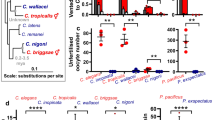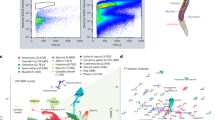Abstract
Understanding how the ageing process is regulated is a fascinating and fundamental problem in biology. Here we demonstrate that signals from the reproductive system influence the lifespan of the nematode Caenorhabditis elegans. If the cells that give rise to the germ line are killed with a laser microbeam, the lifespan of the animal is extended. Our findings suggest that germline signals act by modulating the activity of an insulin/IGF-1 (insulin-like growth factor) pathway that is known to regulate the ageing of this organism. Mutants with reduced activity of the insulin/IGF-1-receptor homologue DAF-2 have been shown to live twice as long as normal1,2,3, and their longevity requires the activity of DAF-16, a member of the forkhead/winged-helix family of transcriptional regulators1,2,4,5. We find that, in order for germline ablation to extend lifespan, DAF-16 is required, as well as a putative nuclear hormone receptor, DAF-12 (refs 6, 7). In addition, our findings suggest that signals from the somatic gonad also influence ageing, and that this effect requires DAF-2 activity. Together, our findings imply that the C. elegans insulin/IGF-1 system integrates multiple signals to define the animal's rate of ageing. This study demonstrates an inherent relationship between the reproductive state of this animal and its lifespan, and may have implications for the co-evolution of reproductive capability and longevity.
This is a preview of subscription content, access via your institution
Access options
Subscribe to this journal
Receive 51 print issues and online access
$199.00 per year
only $3.90 per issue
Buy this article
- Purchase on SpringerLink
- Instant access to full article PDF
Prices may be subject to local taxes which are calculated during checkout




Similar content being viewed by others
References
Kenyon, C., Chang, J., Gensch, E., Rudner, A. & Tabtiang, R. AC. elegans mutant that lives twice as long as wild type. Nature 366, 461–464 (1993).
Larsen, P., Albert, P. & Riddle, D. Genes that regulate both development and longevity in Caenorhabditis elegans. Genetics 139, 1567–1583 (1995).
Kimura, K., Tissenbaum, H., Liu, Y. & Ruvkun, G. daf-2, an insulin receptor-like gene that regulates longevity and diapause in Caenorhabditis elegans. Science 277, 942–946 (1997).
Lin, K., Dorman, J., Roda & A., Kenyon C. daf-16 : an HNF-3/forkhead family member that can function to double the lifespan of C. elegans. Science 278, 1319–1322 (1997).
Ogg, S.et al. The Fork head transcription factor DAF-16 transduces insulin-like metabolic and longevity signals in C. elegans. Nature 389, 994–999 (1997).
Yeh, W.-H. Genes acting late in the signaling pathway for Caenorhabditis elegans dauer larva development.Thesis, Univ. Missouri(1991).
Riddle, D. & Albert, P. in C. elegans II (eds Riddle, D., Blumenthal, T., Meyer, B. & Priess, J.) 739–768 (Cold Spring Harb. Lab. Press, New York, (1997).
Kimble, J. & Hirsh, D. The postembryonic cell lineages of the hermaphrodite and male gonads in Caenorhabditis elegans. Dev. Biol. 70, 396–417 (1979).
de Bono, M. & Bargmann, C. I. Natural variation in a neuropeptide Y receptor homolog modifies social behavior and food response in C. elegans. Cell 94, 679–689 (1998).
Eizinger, A. & Sommer, R. J. The homeotic gene lin-39 and the evolution of nematode epidermal cell fates. Science 278, 452–455 (1997).
Gems, D.et al. Two pleiotropic classes of daf-2 mutation affect larval arrest, adult behavior, reproduction and longevity in Caenorhabditis elegans. Genetics 150, 129–155 (1998).
Morris, J. Z., Tissenbaum, H. A. & Ruvkun, G. Aphosphatidylinositol-3-OH kinase family member regulating longevity and diapause in Caenorhabditis elegans. Nature 382, 536–539 (1996).
Dorman, J. B., Albinder, B., Shroyer, T. & Kenyon, C. The age-1 and daf-2 genes function in a common pathway to control the life span of Caenorhabditis elegans. Genetics 141, 1399–1406 (1995).
Kimble, J. & White, J. G. On the control of germ cell development in Caenorhabditis elegans. Dev. Biol. 81, 208–219 (1981).
Gregoire, F. M., Chomiki, N., Kachinskas, D. & Warden, C. H. Cloning and developmental regulation of a novel member of the insulin-like gene family in Caenorhabditis elegans. Biochem. Biophys. Res. Commun. 249, 385–390 (1998).
Austin, J. & Kenyon, C. Cell contact regulates neuroblast formation in the Caenorhabditis elegans lateral epidermis. Development 120, 313–323 (1994).
Friedman, D. B. & Johnson, T. E. Amutation in the age-1 gene in Caenorhabditis elegans lengthens life and reduces hermaphrodite fertility. Genetics 118, 75–86 (1988).
Acknowledgements
We thank J. Apfeld, K. Lin, R. Kindt, Q. Ch'ng, J. Whangbo, J. Alcedo, J. Dorman, B.Albinder, N. Oliviera, A. Dillon, D. Crawford, D. Garigan and other members of the Kenyon laboratory for discussions and comments on the manuscript. We also thank M. de Bono for providing the wild C.elegans strains and J. Maloof for advice on ablation procedures. This study was supported by an NIH grant to C.K.
Author information
Authors and Affiliations
Corresponding author
Rights and permissions
About this article
Cite this article
Hsin, H., Kenyon, C. Signals from the reproductive system regulate the lifespan of C. elegans. Nature 399, 362–366 (1999). https://doi.org/10.1038/20694
Received:
Accepted:
Issue Date:
DOI: https://doi.org/10.1038/20694
This article is cited by
-
Jujubae Fructus extract prolongs lifespan and improves stress tolerance in Caenorhabditis elegans dependent on DAF-16/SOD-3
Scientific Reports (2024)
-
The metabolite alpha-ketobutyrate extends lifespan by promoting peroxisomal function in C. elegans
Nature Communications (2023)
-
piRNAs regulate a Hedgehog germline-to-soma pro-aging signal
Nature Aging (2023)
-
Endogenous DAF-16 spatiotemporal activity quantitatively predicts lifespan extension induced by dietary restriction
Communications Biology (2023)
-
Combinatorial interventions in aging
Nature Aging (2023)



